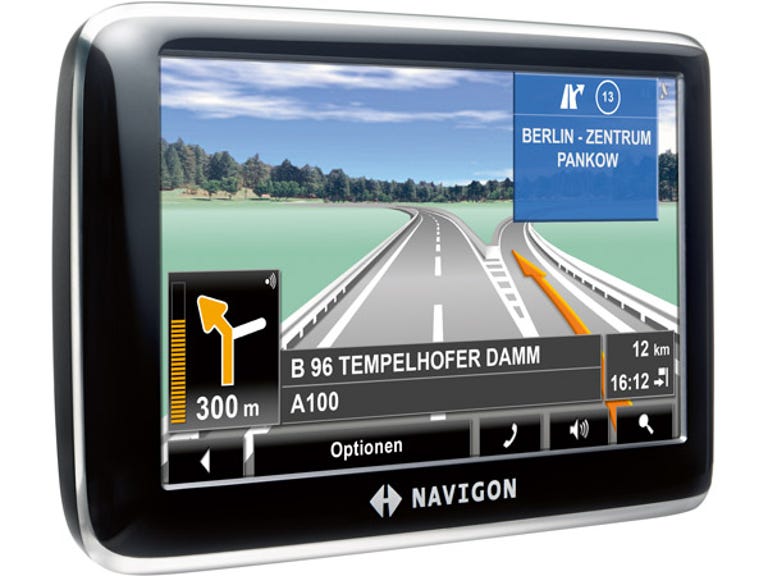 Why You Can Trust CNET
Why You Can Trust CNET Navigon 4350 max review: Navigon 4350 max
It looks good, priced right and has an excellent Bluetooth hands-free set-up, but a host of minor niggles prevents the 4350 max from being a star.
Design
As a latecomer to the Aussie market, Navigon has a lot of uphill battles to fight to gain a foothold here and first impressions of the second-gen models are good. Gone are the entirely piano black bodies, replaced by something altogether sexier. Etched wavy lines adorn the back and a thin band of chrome trim brightens up the front, with piano black relegated to just the screen bezel. It's odd, though, that the power light is on the bottom of the unit and completely invisible when set up.
The Good
The Bad
The Bottom Line
The windshield mount is a funky, L-shaped contraption that resembles a shoe lever suffering from gigantism; a latch at its tip operates the suction cup. The only real bum notes are the mount's size — those with scant covered storage spaces should look elsewhere — and the overly long USB connector that, in some cars, precludes you from placing the 4350 max close to the dash.
While the screen still looks good with a pair of polarised sunnies on, the user interface, with its dominant colours of black and grey, looks both dour and little changed. The menus have been streamlined a bit, but, with its profusion of tabs and the absence of a QWERTY keyboard, destination entry is still on the wrong side of the pleasure/pain continuum. If anything truly bamboozles you there's a handy hypertext manual to help you out. Also praiseworthy are the volume (not just mute and un-mute) and phone controls that are accessible from the main map screen.
Features
At AU$399 the 4350 max is currently the most expensive model in the Navigon range and comes equipped with a 4.3-inch touchscreen, Bluetooth hands-free, text-to-speech, 3D landmarks, multi-stop journeys, lane guidance, junction view, and warnings for speed and red light cameras, as well as school zones. Traffic messaging isn't available, even as an option, nor is music playback or an FM transmitter.
As ever 3D landmarks are a gimmick that obscures streets and other pertinent info, and is better left switched off. To our eyes, the lane guidance graphics, while large, get a little lost in the dull colour palette and the map screen's multitude of buttons and info boxes. In truth, lane guidance and junction view, which replaces the map with a large graphic of an upcoming junction and the appropriate lanes, are pretty rare sighting unless you ply freeways and highways regularly.
We were able to connect a number of phones quickly and easily to the Navigon's Bluetooth hands-free. Volume and clarity were more than fine for on-the-road conversations, with shouting kept to a minimum.
Less successful are the safety camera and school zone warnings. Regardless of whether you're approaching a red light camera, school zone or speed camera, the Navigon's audio cue is always "caution, traffic control ahead". Squint at the screen and you may be able to discern what the speed limit is or what type of warning it is. On the plus side, school zone locations are the most accurate we've encountered thus far, but still not restricted to the times and days when they're in operation.
Performance
Don't expect to unpack the 4350 max and use it straight away. Our 4350 max needed about 15 minutes of charging before it would work. Prior to this it would switch off within a minute of starting; this should be kept in mind if you ever leave the Navigon unused for a long period of time. In our time with the 4350 max, performance in the CBD was good, with few signal drop outs and instances of jumpy positioning, although we may have been lucky in this regard. Although the latest Navteq maps are used, there are still too many missing turn restrictions, even on major roads, like Sydney's Parramatta Road.
Rather like dash-fitted sat nav units, the Navigon will present three possible routes once a destination point has been entered. Calculation time seems to be around par for a portable unit and, as with all navigators, has a preference for main roads. There's a perceptible lag before the unit realises that you've wandered off course, and a succession of missed turns and rather confusing "please turn soon" commands are required before a more sensible route is charted.
Only two female voices are provided and the text-to-speech system's effectiveness suffers a little through odd intonation and pronunciation of street names. It also tries to be too clever by half, guiding you at some intersections in the direction of a town or suburb, for instance, "at the roundabout take the third exit towards Newtown". On all but a few occasions these suburb-based instructions bore no correlation to the suburbs listed on road signs, if indeed there's a road sign there to begin with. And in the course of one roundabout strewn street we were apparently heading toward three different suburbs. At least the speaker is nice and loud.
Conclusion
The 4350 max acquits itself well and at AU$399 is one of the cheapest portable nav units around with Bluetooth hands-free, but a series of persistent niggles (no QWERTY keyboard, generic warnings, text-to-speech faults) take the lustre off slightly.


